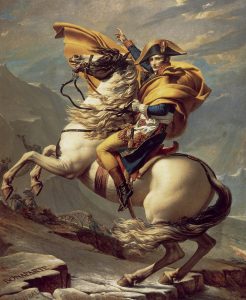
In the history of the western world the figure of Napoleon Bonaparte, Emperor of France and King of Italy, is comparable only to that of Julius Caesar. Like him, Napoleon was an unparalleled military genius and a great legislator, in a moment of transition from one historical era to another, deeply marked by the upheavals of the French Revolution.
In 1796, he was sent to fight on a front considered secondary, Italy, with an army of 38,000 poorly equipped soldiers, but the war results were extraordinary, so also were his “art thefts” (Wescher). Napoleon’s advance was favourably seen both in the cities submitted to Austria, and in the territories of the Papal State where Bologna, Ferrara, Ancona and the occupation of Rome itself were falling in rapid succession. In our country the Napoleonic commissioners were in charge of requisitions. In addition to the painter and collector Wicar, was the painter Antoine Gros, who had long stayed in Italy, the sculptor Jean-Baptiste Moitte, and the engraver Dutertre. Many of them already had a good knowledge of Italy but they used also guide books, collections of engravings as well as reports of travelers of the “Grand Tour” with their descriptions of the main masterpieces kept in churches and palaces.
Napoleon’s march met with no obstacles: even in the States of the Church the intolerance for the papal government was so strong as to make Napoleon appear to be a “liberator”, and as such he was greeted by Foscolo, who in 1799 dedicated a famous ode to him (“To Napoleon Liberator “).
To give a semblance of legitimacy to the raids perpetrated by his armies, Napoleon had included the requisitions of works of art in the clauses of the armistices and peace treaties: the forced transfer of so many masterpieces would thus be included in the agreements and, instead of appearing as an abuse, it would have been accepted as part of the obligations of the vanquished. As for the moral aspects, the Directoire justified itself by claiming that the works of art, as created by free spirits, had to be brought into the homeland of freedom, France, which would also have provided for their better preservation.
The richest haul was collected in Rome, where French troops entered in February 1798. Pope Pius VI Braschi – the great proponent of the “Pius Clementinus Museum” – was deposed, taken prisoner and sent to France where he died the following year. In the Papal States the Republic was proclaimed. The French commissioners then entered into action and dedicated themselves to the requisition of works of art, while assuring the population that the ancient monuments would not be touched. In reality they entertained the idea of removing the two colossal statues of the “Dioscuri” in front of the “Quirinale” and of dismantling the “Trajan Column”, projects fortunately abandoned due to the impossibility of realizing them. On the other hand the sculptures, which had been admired in “The Courtyard of Statues” by Bramante since the Renaissance – such as the “Laocoon”, the “Apollo of the Belvedere”, the “Nile” and the “Tiber”, the “Sleeping Ariadne”, the “Torso” – or masterpieces of the Capitoline Museums as the “Spinario” (“Boy with Thorn”) donated by Sisto IV in 1471, the “Pudica Venus”, the “Discobolus”, all took the road to Paris. As it happens in the turbulent days of every occupation, there were countless episodes of vandalism. Furthermore, the French commissioners, once they had drawn up the list of works to be sent to Paris, began to trade, selling off a quantity of paintings and sculptures considered to be of lower quality.
On 27 and 28 July a very long procession paraded through the streets of Paris to reach the Louvre Museum and a shrewd and spectacular show renewed the glories of the Roman triumphs with an exhibition of the conquered treasures. The boxes were marked by large writings that indicated their contents, but the most famous “preys”, such as the “Laocoon” and the “Horses of San Marco”, were offered, unpacked, to the astonishment of the citizens. The great absentee from this grand parade was Napoleon Bonaparte, who had embarked for Egypt, opening a new front of hostility. Having abandoned the ideals of the “Musée Révolutionnaire”, the great French museum, renamed “Musée Napoléon” since 1803, now takes on the glorification aspect of Napoleonic power, an image of the political and cultural supremacy of France seen through the exhibition of the most representative masterpieces of the great traditions of European States.
So much power was identified in the Louvre Museum that in 1810, Napoleon’s wedding to Maria Luisa of Austria was celebrated in the “Grande Gallerie”, which was cleared of paintings and sculptures for the occasion.
In 1815 the Battle of Waterloo marked the end of the Napoleonic era, but some “art thefts” from the Italian Peninsula remained and are still in France today: the “Tiber” statue, The “Crowning of thorns”, painted by Titian and other relevant masterpieces.
Excerpt from: Maria Teresa Iorio, Il museo nella storia , Pearson, 2018, pp 76-81





Leave a Reply
Want to join the discussion?Feel free to contribute!